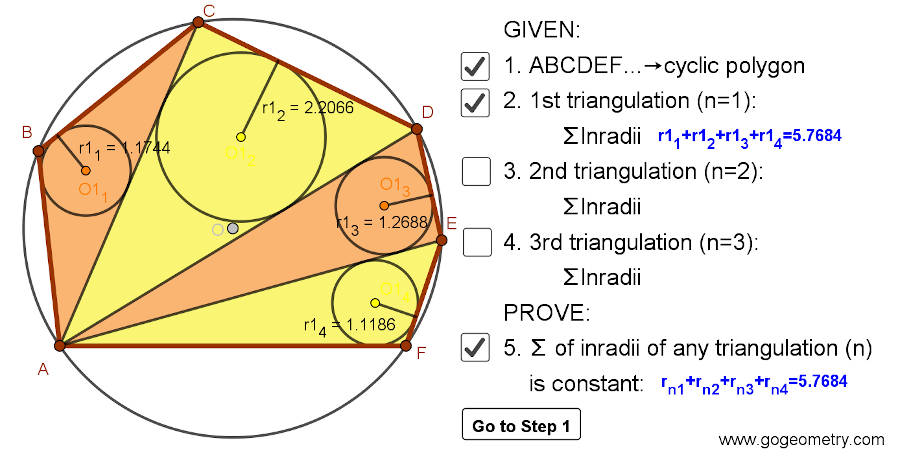Dynamic Geometry 1480 with Solution: Japanese Theorem for Cyclic Polygon, Sangaku, Triangulation, Non-intersecting Diagonals, Sum of Inradii, Invariant, Step-by-step Illustration
Let a cyclic polygon be triangulated in any manner by non-intersecting diagonals. Prove that the sum of the inradii of the triangles formed is a constant independent of the triangulation chosen (invariant).
Reference: Weisstein, Eric W. "Japanese Theorem." From MathWorld--A Wolfram Web Resource. https://mathworld.wolfram.com/JapaneseTheorem.html
Static Diagram of Dynamic Geometry 1480

Poster of Dynamic Geometry 1480 using iPad Apps

Search gogeometry.com
Classroom Resource:
Interactive step-by-step animation using GeoGebra
This step-by-step interactive illustration was created with GeoGebra.
- To explore (show / hide): click/tap a check box.
- To stop/play the animation: click/tap the icon in the lower left corner.
- To go to first step: click/tap the "Go to step 1" button.
- To manipulate the interactive figure: click/tap and drag the blue points or figures.
GeoGebra is free and multi-platform dynamic mathematics software for all levels of education that joins geometry, algebra, tables, graphing, statistics and calculus application, intended for teachers and students. Many parts of GeoGebra have been ported to HTML5.
Recent Additions
Geometry Problems
Open Problems
Visual Index
Ten problems: 1411-1420
All Problems
Triangle
Circle
Cyclic Poligon
Triangle Centers
Incenter, Inradius, Inradii
Angle Bisector
Sangaku Japanese Geometry
GeoGebra
HTML5 and Dynamic Geometry
iPad Apps
View or Post a solution